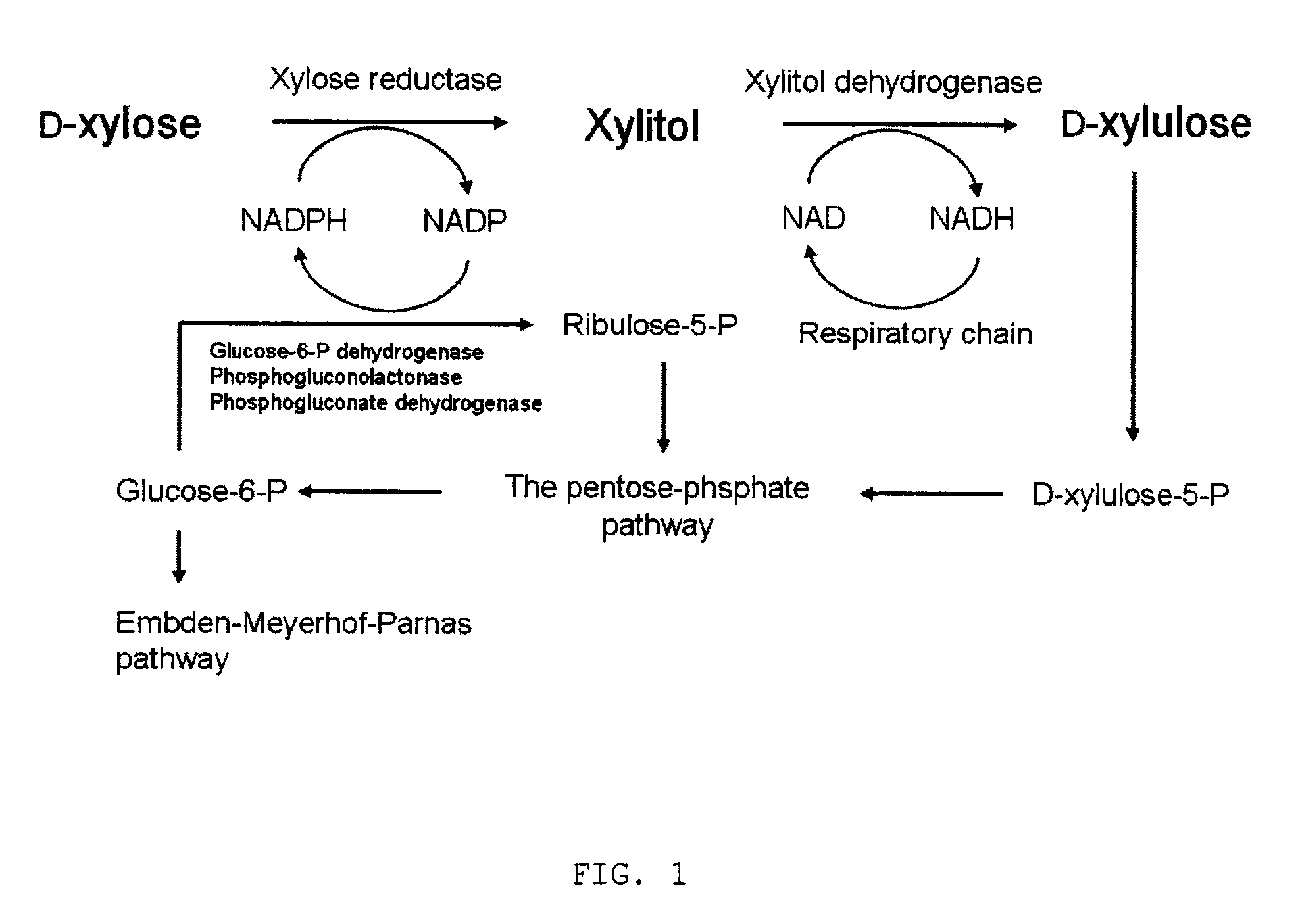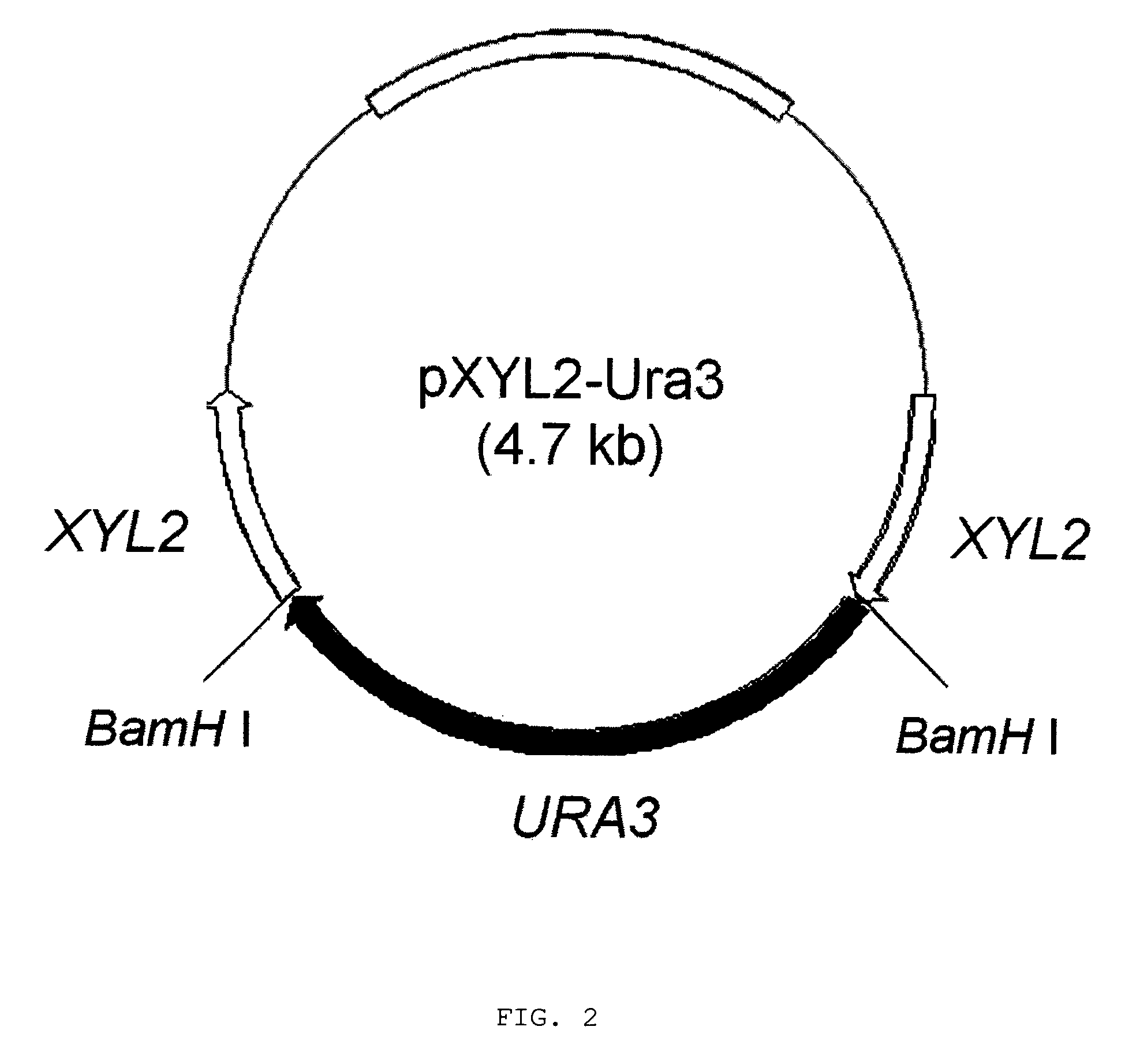Method for manufacturing xylitol with high-yield and high-productivity
a technology of xylitol and high yield, which is applied in the field of manufacturing xylitol with high yield and highproductivity, can solve the problems of high cost and polluting step of purifying pure d-xylose, dangerous and polluting hydrogenation of d-xylose to xylitol at high temperature and high pressure using raney-nickel metal catalyst, and the industrial production of xylitol has yet to be achieved
- Summary
- Abstract
- Description
- Claims
- Application Information
AI Technical Summary
Benefits of technology
Problems solved by technology
Method used
Image
Examples
example 1
Construction of Xylitol Dehydrogenase-Deficient Mutant of Candida tropicalis
[0027]C. tropicalis genomic DNA was prepared using a total DNA extraction kit. The partial XYL2 gene was amplified by polymerase chain reaction (PCR). The DNA sequences of the primers used are as follows:
[0028]
Primer XYL2-F:5′-aatggtcttgggtcacgaatcc-3′(SEQ ID NO: 1)Primer XYL2-R:5′-gctctgaccaagtcgtaggcttc-3′(SEQ ID NO: 2)
[0029]The resulting fragment was purified using a PCR product purification kit and then inserted into pGEM-T Easy vector (PROMEGA, USA). Then, two target sites for BamHI restriction enzyme were introduced at the both ends of XYL2 gene fragment cloned in pGEM-T Easy vector and the resulting plasmid was referred as pGEM-XYL2. A 1.2-kb URA3 gene was amplified by PCR with genomic DNA of C. tropicalis using primers Ura3-F and Ura3-R. The DNA sequences of the primers used were as follows:
[0030]
Primer Ura3-F:(SEQ ID NO: 3)5′-ggatccattctagatgatctggtttggattgttggag-3′Primer Ura3-R:(SEQ ID NO: 4)5′-gg...
example 2
Xylitol Production Using a Genetically Modified Strain
[0032]The modified strain, BS-xdh, which was constructed as described in Example 1 was inoculated in 15-ml test tube containing 3 ml of YM medium (3 g l−1 yeast extract, 3 g l−1 malt extract, 5 g l−1 bactopeptone, and 20 g l−1 glucose) and incubated using shaking incubator at 30° C. and 200 rpm for 12 hours. 1 ml of the said seed culture was inoculated in 250-ml flask containing 50 ml of xylitol production medium (50 g l−1 D-xylose, 10 g l−1 glucose, 10 g l−1 yeast extract, 5 g l−1 potassium dihydrogenphosphate, and 0.2 g l−1 magnesium sulfate heptahydrate) and incubated using shaking incubator at 30° C. and 200 rpm for 36 hours. The samples (sample 1 to 7) were acquired every 6 hours.
[0033]Dry cell concentrations (dry cell weight per 1 L of culture), and concentrations of D-xylose, and xylitol of the sample 1 to 7 were analyzed, respectively. Dry cell weight was calculated from optical density of the sample using a spectrophotom...
example 3
Screening of Cosubstrate for Cofactor Regeneration
[0036]The modified strain, BS-xdh, which was constructed as described in Example 1 was inoculated in 15-ml test tube containing 3 ml of YM medium (3 g l−1 yeast extract, 3 g l−1 malt extract, 5 g l−1 bactopeptone, and 20 g l−1 glucose) and incubated using shaking incubator at 30° C. and 200 rpm for 12 hours. 1 ml of the said seed culture was inoculated in 250-ml flasks containing 50 ml of various xylitol production media (50 g l−1 D-xylose, 10 g l−1 various carbon sources shown in TABLE 2 below, 10 g l−1 yeast extract, 5 g l−1 potassium dihydrogenphosphate, and 0.2 g l−1 magnesium sulfate heptahydrate), and incubated using shaking incubator at 30° C. and 200 rpm for 96 hours.
[0037]After the end of fermentation, concentrations of produced dry cell (A), consumed various cosubstrates (B), consumed D-xylose (C), and produced xylitol (D) were measured as described previously. The D-xylose conversion ratio (E) was calculated from the consu...
PUM
| Property | Measurement | Unit |
|---|---|---|
| temperature | aaaaa | aaaaa |
| temperature | aaaaa | aaaaa |
| pH | aaaaa | aaaaa |
Abstract
Description
Claims
Application Information
 Login to View More
Login to View More - R&D
- Intellectual Property
- Life Sciences
- Materials
- Tech Scout
- Unparalleled Data Quality
- Higher Quality Content
- 60% Fewer Hallucinations
Browse by: Latest US Patents, China's latest patents, Technical Efficacy Thesaurus, Application Domain, Technology Topic, Popular Technical Reports.
© 2025 PatSnap. All rights reserved.Legal|Privacy policy|Modern Slavery Act Transparency Statement|Sitemap|About US| Contact US: help@patsnap.com



